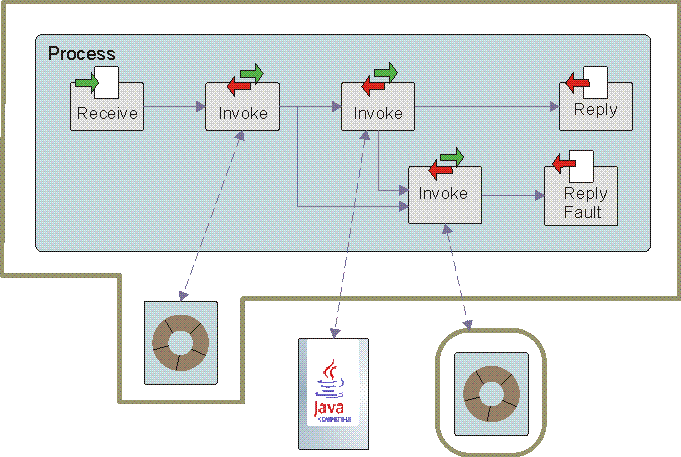
Transactional behavior of microflows
Microflows are short-lived BPEL processes. They can run either in a transaction, or in an activity session as specified on the SCA component of the microflow. Microflows that are executed as part of a transaction are explained here.
Microflows are not interruptible. Therefore, a microflow cannot contain activities that wait for an external event, or for a user interaction, for example, human task activities.
Microflows are transient. The process instance state of a microflow is held in memory, and not stored in the runtime database. However, the state of a microflow instance can be persisted in the audit log or in Common Base Events.
The following diagram shows the transaction of a microflow and the services that the microflow interacts with. The services inside the transaction boundary participate in the microflow transaction; those outside the boundary do not participate in the transaction.

Invoked services and microflow transactions
A microflow runs in one transaction. However, the services that the microflow invokes can involve more than one transaction. This is because a service that is called through an invoke activity can either participate in the transaction of the microflow, or it can run in its own transaction.
- The interaction style that is used to call the service.The interaction style can be synchronous or asynchronous. The style is determined by the preferred interaction style of the target Service Component Architecture (SCA) component or the SCA import, and whether the operation is one-way operation or a request-response operation as shown in the following table:
Table 1. Preferred interaction style of the target component or import One-way operation Request-response operation Any Asynchronous invocation Synchronous invocation Synchronous Synchronous invocation Synchronous invocation Asynchronous Asynchronous invocation Synchronous invocation Note: The invocation from a microflow of a request-response operation with a preferred interaction style of "asynchronous" is an example of an antipattern for service invocation. When the invoked service is a long-running process, the microflow transaction can time out before the long-running process completes, and a runtime error occurs. - The SCA transaction qualifiers that are specified
for the process and the service that is called:
- The suspendTransaction qualifier on the reference of the process component specifies whether the transaction context of the process is propagated to the services to be invoked.
- The joinTransaction qualifier on the service interface specifies whether a service participates in the transaction of its caller if a transaction is propagated.
Based on these settings, the following rules apply to the invoked service:
- Synchronous invocation
joinTransaction suspendTransaction = true suspendTransaction = false joinTransaction = true The service does not participate in the microflow transaction The service participates in the microflow transaction joinTransaction = false The service does not participate in the microflow transaction The service does not participate in the microflow transaction If a service participates in a microflow transaction, the changes that are made by the service to the transactional resources are persisted only if the microflow transaction commits. If a service does not participate in the microflow transaction, the changes that are made by the service to the transactional resources might be persisted even if the transaction is rolled back. You can use compensation to undo the changes made by the service.
- Asynchronous invocation
- The service always runs in its own transaction. To ensure that the sending of the asynchronous SCA message participates in the current navigation transaction, the asynchronousInvocation qualifier of the microflow must be set to commit.